
2023
AP
®
Statistics
Sample Student Responses
and Scoring Commentary
© 2023 College Board. College Board, Advanced Placement, AP, AP Central, and the acorn logo are registered
trademarks of College Board. Visit College Board on the web: collegeboard.org.
AP Central is the ocial online home for the AP Program: apcentral.collegeboard.org.
Inside:
Free-Response Question 6
Scoring Guidelines
Student Samples
Scoring Commentary

AP® Statistics 2023 Scoring Guidelines
© 2023 College Board
Question 6: Investigative Task 4 points
General Scoring Notes
• Each part of the question (indicated by a letter) is initially scored by determining if it meets the criteria for
essentially correct (E), partially correct (P), or incorrect (I). The response is then categorized based on the
scores assigned to each letter part and awarded an integer score between 0 and 4 (see the table at the end of
the question).
• The model solution represents an ideal response to each part of the question, and the scoring criteria identify
the specific components of the model solution that are used to determine the score.
Model Solution Scoring
(a)
Let X represent the amount of gold applied to a
necklace randomly selected from necklaces
produced with this machine. The random
variable X has an approximately normal
distribution with mean 300 mg and standard
deviation 5 mg.
Then,
( ) ( )
(296 304)
( 304) ( 296)
304 300 296 300
=
55
( 0.8) ( 0.8)
0.7881 0.2119 0.5763.
PX
PX PX
PZ PZ
PZ PZ
<<
=<−≤
−−
< −≤
= < − ≤−
≈−≈
Essentially correct (E) if the response satisfies the
following three components:
1. Indicates the use of a normal distribution with
mean 300 and standard deviation 5
2. Specifies the correct event (boundary value and
direction) or an event consistent with values
reported in component 1
3. Provides the correct probability of 0.5763 or a
probability consistent with components 1 and 2
Partially correct (P) if the response satisfies only
two of the three components.
Incorrect (I) if the response does not satisfy the
criteria for E or P.
Additional Notes:
Component 1
• A response may satisfy component 1 by any of the following or a combination of the following:
o G
raphical: Displaying a graph of a normal density function with the appropriate scale on the horizontal
axis showing the mean and the standard deviation for the distribution of the amount of gold applied to
the necklaces.
o Calculator function syntax: Labeling correct values of the mean and standard deviation in a
“
normalcdf
” statement, such as:
( )
normalcdf lower 296, upper 304, mean 300, standard deviation 5 .= = = =
Correct specification of the lower and upper bounds is not required to satisfy component 1.
o W
ords: Using a statement such as “normal distribution with mean 300 and standard deviation 5.”
o Standard Notation: Using standard notation such as
(300,5)N
or
( )
2
(300, 5 ).N
o Z-score: Displaying the correct mean and standard deviation in a z-score calculation that includes “z,”
such as
304 300
.
5
z
−
=

AP® Statistics 2023 Scoring Guidelines
© 2023 College Board
Component 2
• A response may satisfy component 2 by any of the following or a combination of the following:
o Graphical: Displaying a graph of a normal density function with the region of interest
(
296 amount of gold 304<<
or
0.8 0.8Z− <<
) clearly identified. The shaded area does not need to
be proportional, but the boundaries should be on the proper side of the mean and the shading should be
in the proper direction.
o Calculator function syntax: Labeling the lower and upper bounds of the region of interest in a
“normalcdf” statement, such as:
( )
normalcdf lower 296, upper 304, mean 300, standard deviation 5 .= = = =
( )
normalcdf lower 0.8, upper 0.8, 0, 1 .
µσ
=−===
o Words: Specifying the correct event in words with correct numerical value for the boundary value and
correct direction, such as “the probability that the amount of gold applied to a randomly selected
necklace is between 296 and 304 mg” or
(296 amount of gold 304).P <<
o Standard Notation: Using standard notation such as
( )
296 304PX<<
or
( )
296 300 304 300
55
PZ
−−
<<
or
( 0.8 0.8).PZ− <<
General
• Minor errors in statistical notation may be ignored. However, this is considered poor communication if
holistic scoring is required.
• If the only error in the response to part (a) is the reversal of the numerator for the z-score,
( )
300 296−
or
( )
300 304 ,−
the response is scored P.
• An arithmetic or transcription error in a response can be ignored if correct work is shown.
• A response that satisfies components 1 and 2 by including more than calculator syntax (e.g., standard
random variable notation and probability notation) is considered good communication and may be
considered if holistic scoring is required.
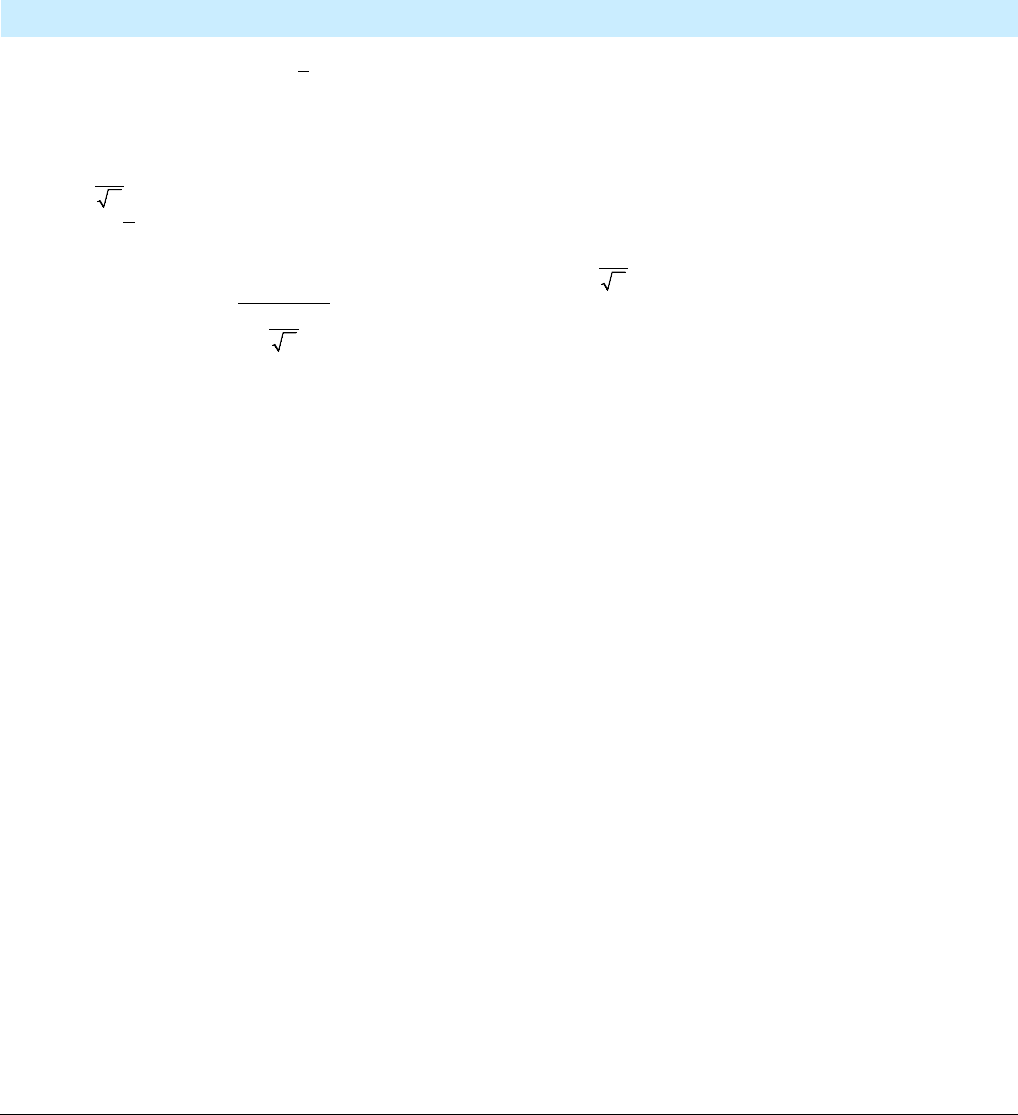
AP® Statistics 2023 Scoring Guidelines
© 2023 College Board
Model Solution
Scoring
(b)
(i) If the machine is working properly, and the sample
mean amount of gold,
X
, has a sampling
distribution that follows a normal distribution with
mean 300 mg and standard deviation
5
3.5355 mg,
2
≈
then
( 303)
303 300
=
5
2
( 0.8485)
0.198.
PX
PZ
PZ
>
−
>
≈>
≈
(ii) Observing a sample mean amount of 303 mg
would not provide convincing evidence that the
population mean amount of gold being applied by
the machine is something other than 300 mg
because the probability of observing a sample
mean that differs from 300 mg by 3 mg or more is
large, around
0.198(2) 0.396.=
Essentially correct (E) if the response satisfies
components 1, 4, and 5 AND at least one of
components 2 or 3:
1. In part (b-i), indicates the use of a normal (or
an approximately normal) distribution and
identifies the correct parameter values (mean
300 mg and standard deviation
5
3.5355 mg
2
≈
) with work shown or a
correct formula
2. In part (b-i), specifies the correct event
(boundary value and direction)
3. In part (b-i), provides the correct probability
of 0.198 or the probability consistent with
components 1 and 2
4. In part (b-ii), indicates whether observing a
sample mean of 303 mg would provide
convincing evidence that the population mean
is not 300 mg, consistent with the response to
part (b-i)
5. In part (b-ii), provides justification based on
the probability obtained in part (b-i) or a
correctly computed probability in part (b-ii)
Partially correct (P) if the response does not
meet the requirements for E and satisfies at least
three of the five components
OR
the response satisfies only components 4 and 5,
consistent with the response to part (b-i)
OR
the response satisfies only component 1 and one
of the other four components.
Incorrect (I) if the response does not meet the
criteria for E or P.
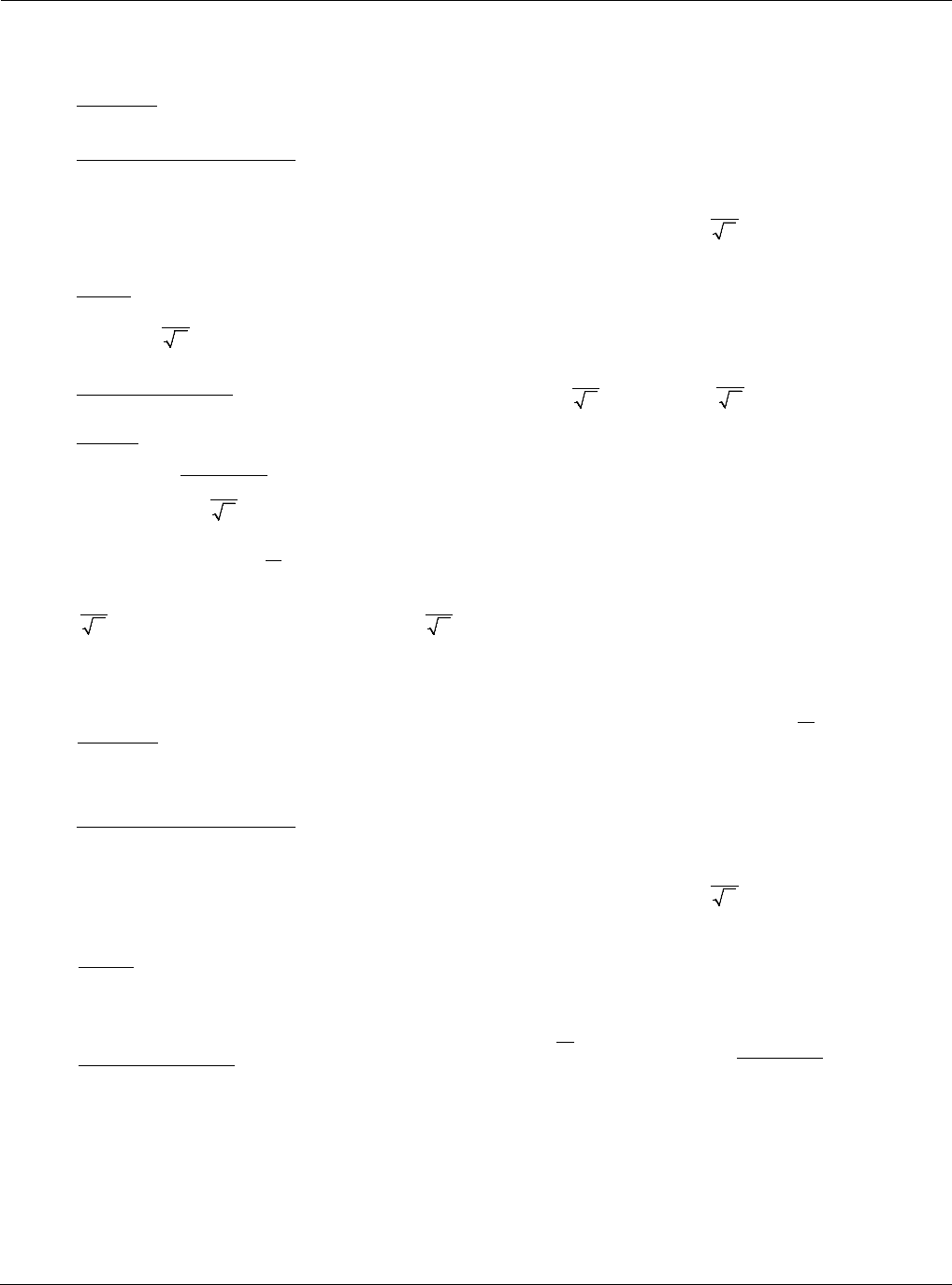
AP® Statistics 2023 Scoring Guidelines
© 2023 College Board
Additional Notes:
Component 1
• A response may satisfy component 1 by any of the following or a combination of the following:
o Graphical: Displaying a graph of a normal density function with the appropriate scale on the horizontal
axis showing mean and standard deviation for the distribution of mean amount of gold.
o Calculator function syntax: Labeling correct values of the mean and standard deviation in a “normalcdf”
statement, such as “normalcdf” or “ncdf”, e.g.,
( )
5
normalcdf lower 303, upper , mean 300, standard deviation .
2
= =∞= =
Correct specification of the upper and lower bounds is not required to satisfy component 1.
o Words: Using a statement such as “approximately normal distribution with mean 300 and standard
deviation
5
.
2
”
o Standard Notation: Using standard notation such as
( )
5
300,
2
N
or
( )
2
5
300, .
2
N
o Z-score: Displaying the correct mean and standard deviation in a z-score calculation, which includes “z,”
such as
303 300
.
5
2
z
−
=
o To satisfy the supporting work criterion of component 1 the response must clearly indicate that the
standard deviation for
X
is computed by dividing 5 by the square root of 2. This may be indicated with
5
2
,
words, or standard notation such as
.
n
σ
Component 2
• A response may satisfy component 2 by any of the following or a combination of the following:
o Graphical: Displaying a graph of a normal density function with the region of interest (
303X >
or
0.8485Z >
) clearly identified. The shaded area does not need to be proportional, but the boundary
should be on the proper side of the mean and the shading should be in the proper direction.
o Calculator function syntax: Labeling the lower and upper bounds of the region of interest in a
“normalcdf” statement, such as:
( )
5
normalcdf lower 303, upper , mean 300, standard deviation .
2
= =∞= =
( )
normalcdf lower 0.8485, upper , 0, 1 .
µσ
= =∞= =
o Words: Specifying the correct event in words with correct numerical value for the boundary and correct
direction, such as the “probability that the mean amount of gold applied to two randomly selected
necklaces is greater than 303 mg” or
(mean amount of gold 303).P >
o Standard Notation: Using standard notation such as or
( )
303PX>
or
( )
303 300
3.5355
PZ
−
>
or
( )
.0.8485PZ>
Component 3
• A response may satisfy component 3 if the reported probability is consistent with components 1 and 2. If a
normal distribution with a mean of 300 mg and standard deviation 5 mg is used, the probability reported
should be 0.274.

AP® Statistics 2023 Scoring Guidelines
© 2023 College Board
General
• Minor errors in statistical notation may be ignored. However, this is considered poor communication and
may be considered if holistic scoring is required.
• If the only error in part (b) is the reversal of the numerator for the z-score
( )
300 303 ,−
the response is
scored P.
• An arithmetic or transcription error in a response can be ignored if correct work is shown.
Alternate Solution:
• A response that calculates the probability that the total amount of gold on the two randomly selected
necklaces is greater than 606 mg
( )
2 303mg×
can be scored essentially correct if the response
demonstrates:
o The use of a normal (or approximately normal) distribution and the correct mean and standard deviation
for the distribution of the total amount of gold applied to two randomly selected necklaces, (e.g.,
( )
600,7.071 ,N
or mean
2(300) 600 mg= =
and standard deviation
( )
2
2 5 7.071 mg,= ≈
or
606 600
0.8485
7.071
z
−
= ≈
), satisfying component 1.
o Specifies the correct event, including the correct boundary value of
2(303) 606
total
x = =
or
0.8485,z ≈
and the correct direction, satisfying component 2.
o The probability is correctly computed using the mean and the standard deviation of the total amount of
gold applied to two randomly selected necklaces. An arithmetic error can be ignored if correct work is
shown and the result is between 0 and 0.5.
• While the probability of a difference in part (b-ii) is twice the probability found in part (b-i), it is not
necessary for a response to double the probability in part (b-i). However, if the probability in part (b-i) is
doubled, that should be considered if holistic scoring is required.

AP® Statistics 2023 Scoring Guidelines
© 2023 College Board
Model Solution Scoring
(c)
(i) The sampling distribution of the sample
range for random samples of size
2n =
from a normal distribution with standard
deviation
5
σ
=
is skewed to the right.
Almost all values of the simulated ranges
are between 0 mg and about 25 mg and the
center of the distribution is about 6 mg.
(ii) As the value of the population standard
deviation increases, the variation (spread) in
the distribution of the sample range
increases and the mean of the distribution of
the sample range also increases.
Essentially correct (E) if the response satisfies four
or five of the following five components:
1. In part (c-i), describes the shape as positively
skewed (or skewed to the right)
2. In part (c-i), describes the center of the
distribution as about 6 mg
3. In part (c-i), describes the spread of the
simulated sample ranges as having most values
between 0 mg and 30 mg
4. In part (c-ii), indicates that the mean (or center)
of the distribution of the sample range increases
as the population standard deviation increases
5. In part (c-ii), indicates that the variation (or
spread) of the distribution of the sample range
increases as the population standard deviation
increases
Partially correct (P) if the response satisfies three
of the five components
OR
the response satisfies only components 4 and 5
OR
the response only satisfies components 2 and 4
OR
the response satisfies only components 3 and 5.
Incorrect (I) if the response does not meet the
criteria for E or P.
Additional Notes:
• The centrality component of the response to part (c-i) may be satisfied with any reasonable description of
center, such as a comment on the approximate value of mean or median of the distribution or indication that
the center is somewhere between 4 and 10 mg.
• The spread component of the response to part (c-i) may be satisfied with a reasonable statement about the
inter-quartile range. Any value between 5 and 7, inclusive, is considered reasonable.
• Although the actual range of the sample distribution of the sample range is infinite, a comment that the range
is any value between 20 and 30 may be scored as satisfying the spread component of the response to
part (c-i).
• The response to part (c-ii) need not comment on the skewness of the distributions. Any comment on the
skewness of the distributions should be considered as extraneous in scoring the response.

AP® Statistics 2023 Scoring Guidelines
© 2023 College Board
Model Solution Scoring
(d)
(i) No, a sample range of 10 mg is not unusual if
the machine is working properly with a
standard deviation of 5 mg.
Although observing a sample range around
10 mg or greater is much more likely if the
population standard deviation is 8 mg or
12 mg than when the population standard
deviation is 5 mg, the graph of the sampling
distribution of the sample range for samples
of size 2 from a normal distribution with
5 mg
σ
=
indicates that 10 mg is not an
unusual value for the range when
5 mg
σ
=
.
There is about a 20% chance that a random
sample of two necklaces would yield a range
of 10 mg or more when the machine is
working properly.
(ii) No, Cleo’s sample mean of 303 mg and range
of 10 mg do not indicate that the machine is
not working properly. As noted in part (b-i),
the probability that the sample mean would
be equal to or greater than 303 mg when the
machine is working properly is almost 20%
so having a sample mean of 303 mg is not
unusual. Furthermore, it is less than one
standard deviation,
5
3.5355 mg,
2
=
away
from 300 mg. As indicated in part (d-i), the
probability of a range of 10 mg or greater
when the population standard deviation is 5
mg is also about 20%, so not unusual. There
is not statistically significant evidence to
show the machine is not working properly.
Essentially correct (E) if the response satisfies
four or five of the following five components:
1. In part (d-i), indicates a sample range of 10 mg
is not unusual
2. In part (d-i), justifies the response to
component 1 by indicating that the graph of
the sampling distribution of the sample range
when
5
σ
=
mg shows that values of 10 mg
or greater occur often
3. In part (d-ii), indicates there is not convincing
evidence that the machine is not working
properly
4. In part (d-ii), justifies the response by
indicating that a sample mean of 303 mg
would not be unusual when the machine is
working properly with one of the following
• 303 mg is less than one standard deviation
away from 300 mg
• The probability that the mean is greater
than or equal to 303 mg was shown in (b)
to have probability of 0.198, which is not
unusual
• Some other reasonable justification
5. In part (d-ii), justifies the response by
indicating that a sample range of 10 mg is not
unusual when the machine is working properly
as discussed in part (d-i)
Partially correct (P) if the response does not meet
the requirements for E and satisfies at least three of
the five components
OR
the response satisfies components 1 and 2
OR
the response satisfies component 3 and either
component 4 or 5.
Incorrect (I) if the response does not meet the
criteria for E or P.
Additional Notes:
• An argument that a sample range of 10 mg or more is more likely to occur (or closer to the center of the
sampling distribution of the range) when
8
σ
=
mg or
12
σ
=
mg is not required for component 2, but by
itself does not satisfy component 2. Inclusion of this argument should be considered if holistic scoring is
required.

AP® Statistics 2023 Scoring Guidelines
© 2023 College Board
• Other reasonable justifications to satisfy component 4 include arguments based on a z-value close to zero, a
one-sample z-test or one-sample t-test for a population mean, or a one sample z-interval or t-interval for a
population mean.
Alternate Solutions:
• A response that uses the intersection (or union) of the event ‘the sample mean is greater than or equal to
303 mg’ and the event ‘the sample range is greater than or equal to 10 mg’ can satisfy components 3, 4,
and 5.
o Components 3, 4, and 5 are satisfied if the response shows, for example:
Let
( ) ( )
mean 303 0.198PM P == ≥
(from part b-ii).
Let
( ) (
)
range 10 if 5 0.2
PR P
σ
= ≥=≈
(from part d-i).
For Intersection:
( ) ( ) ( ) ( )( )
0.198 0.2 0.0396,P M and R P M P R
= = =
because this probability
is small, this is evidence that the machine is not working properly.
For Union:
( ) (
)
( ) (
) ( )
( )( )
0.198 0.2 0.198 0.2 0.3584,
PMorR PM PR PM PR=+=− = +−
because this probability is large, this is not evidence that the machine is not working properly.
General Notes:
• Context (amount of gold in necklaces) is not required in parts (a), (b), (c), or (d) of the response. However,
including context is considered good communication and may be considered if holistic scoring is required.
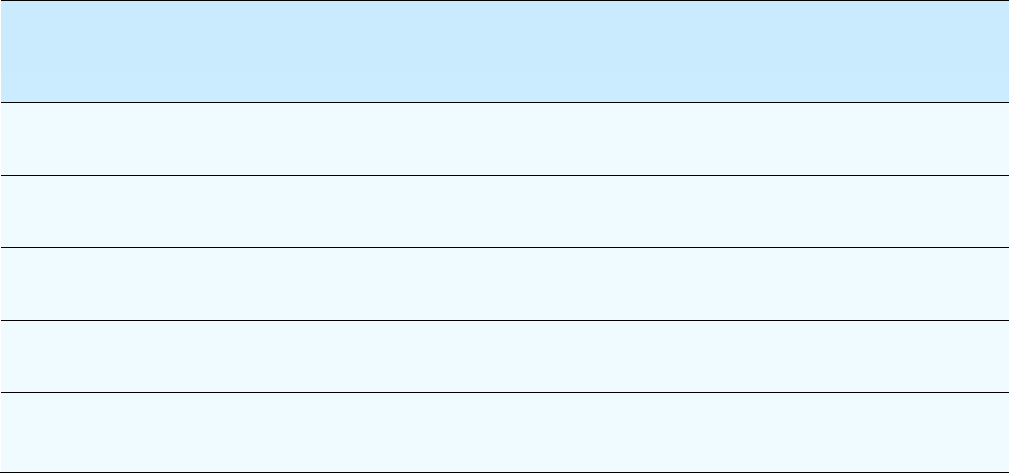
AP® Statistics 2023 Scoring Guidelines
© 2023 College Board
Scoring for Question 6
Each essentially correct (E) part counts as 1 point, and each partially correct (P) part counts as ½ point.
Score
Complete Response 4
Substantial Response 3
Developing Response 2
Minimal Response 1
If a response is between two scores (for example, 2 ½ points), use a holistic approach to decide whether to
score up or down, depending on the strength of the response and quality of the communication.
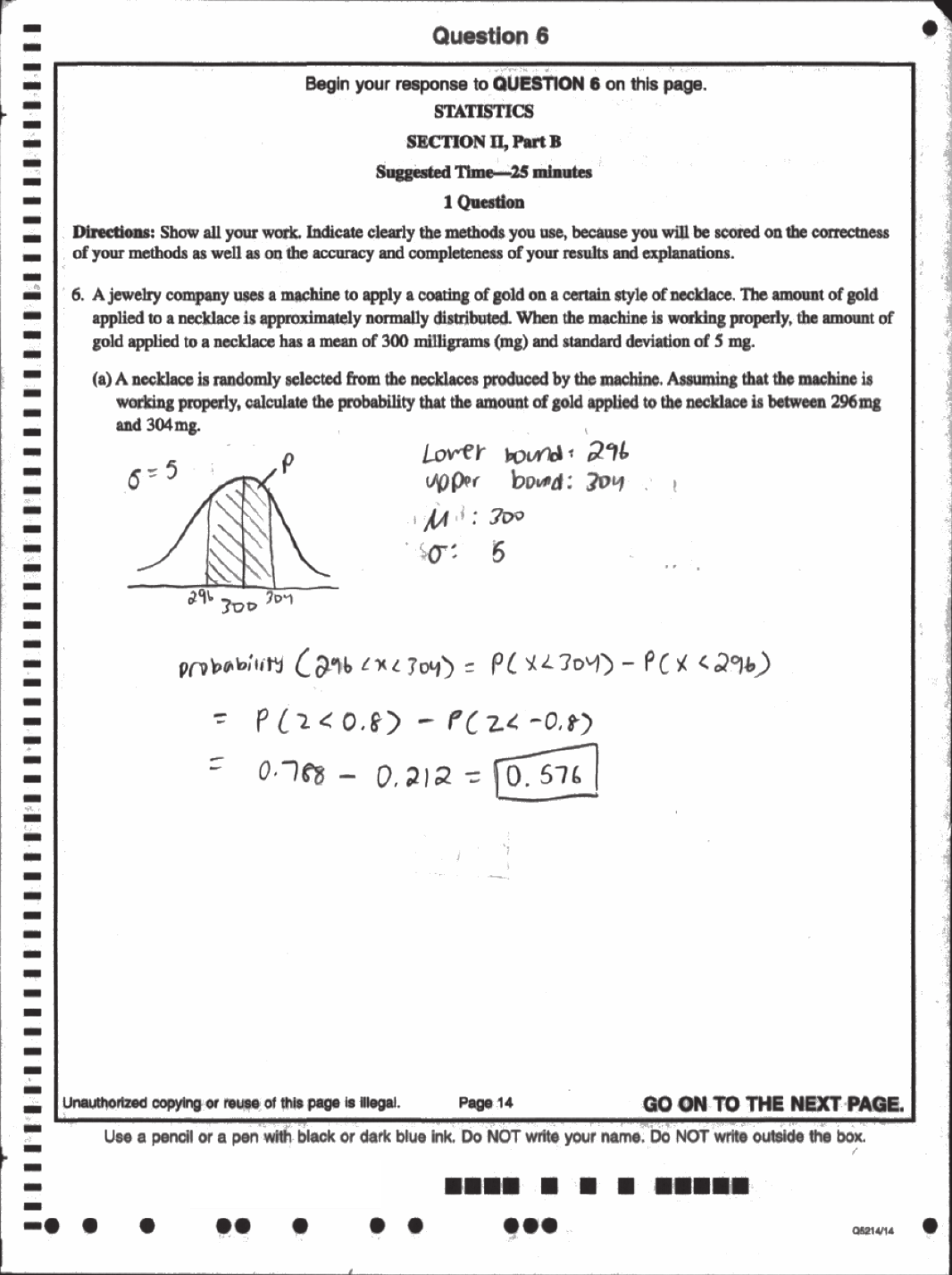
Sample 6A
1 of 5
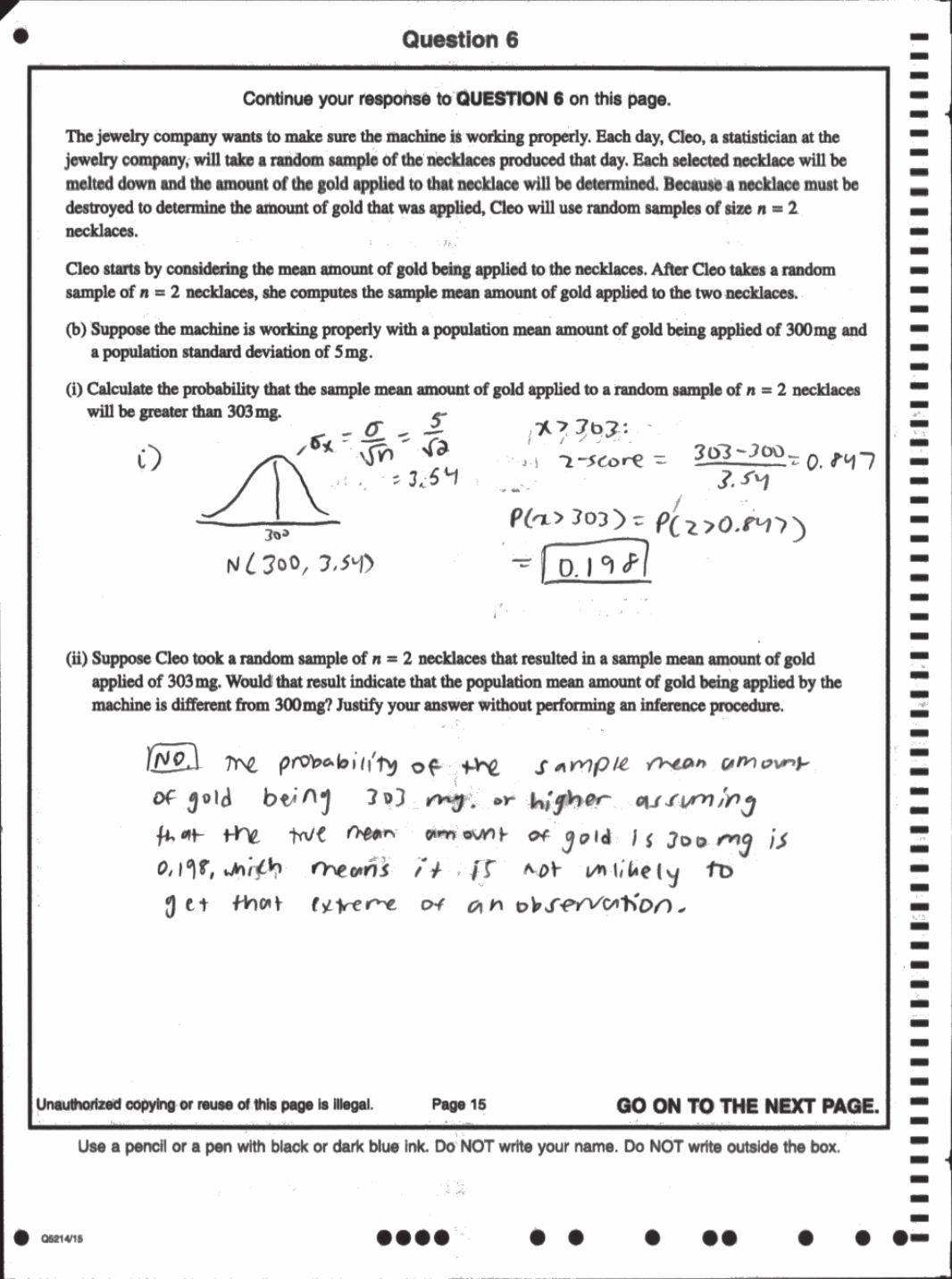
Sample 6A
2 of 5

Sample 6A
3 of 5
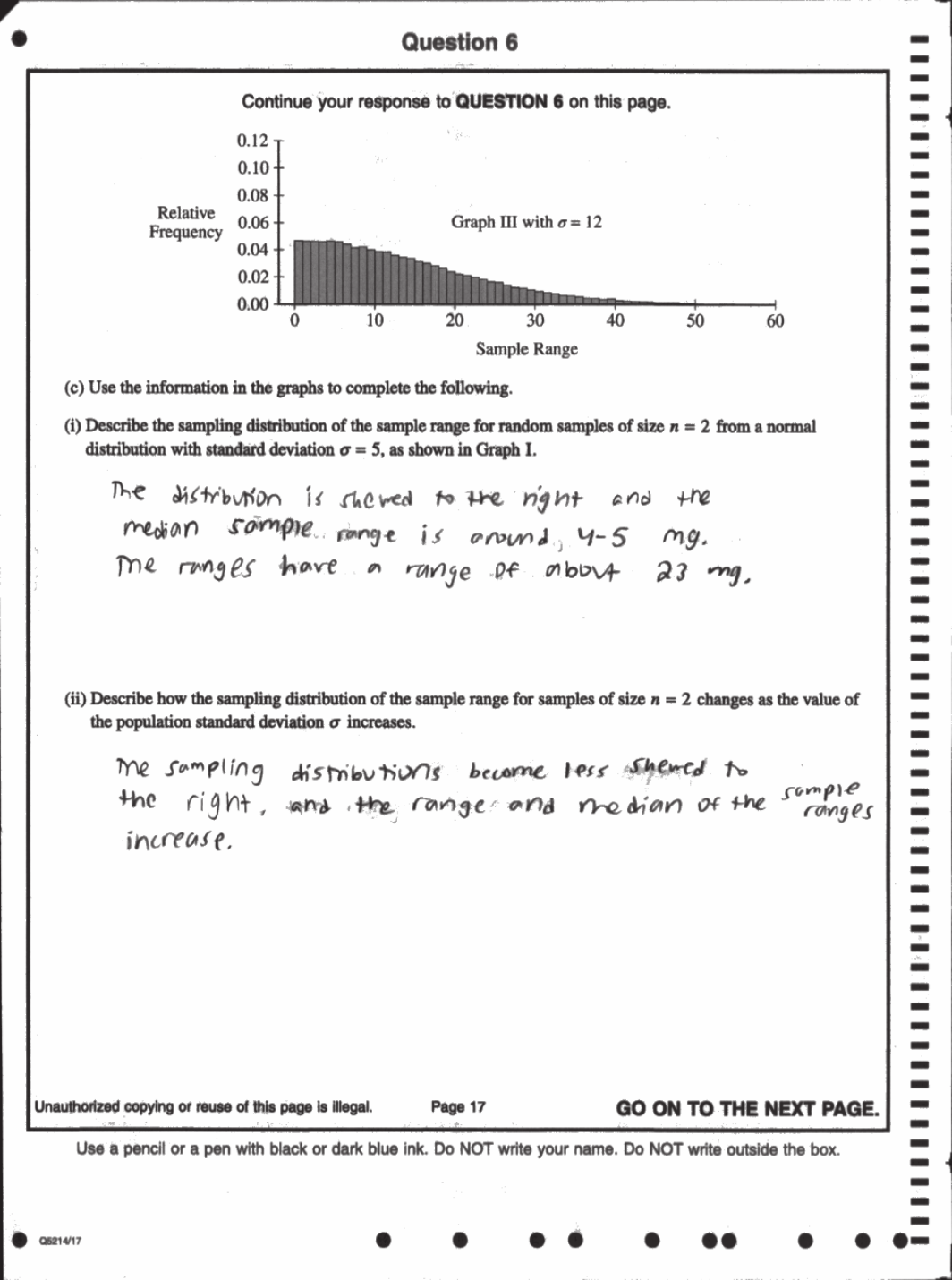
Sample 6A
4 of 5
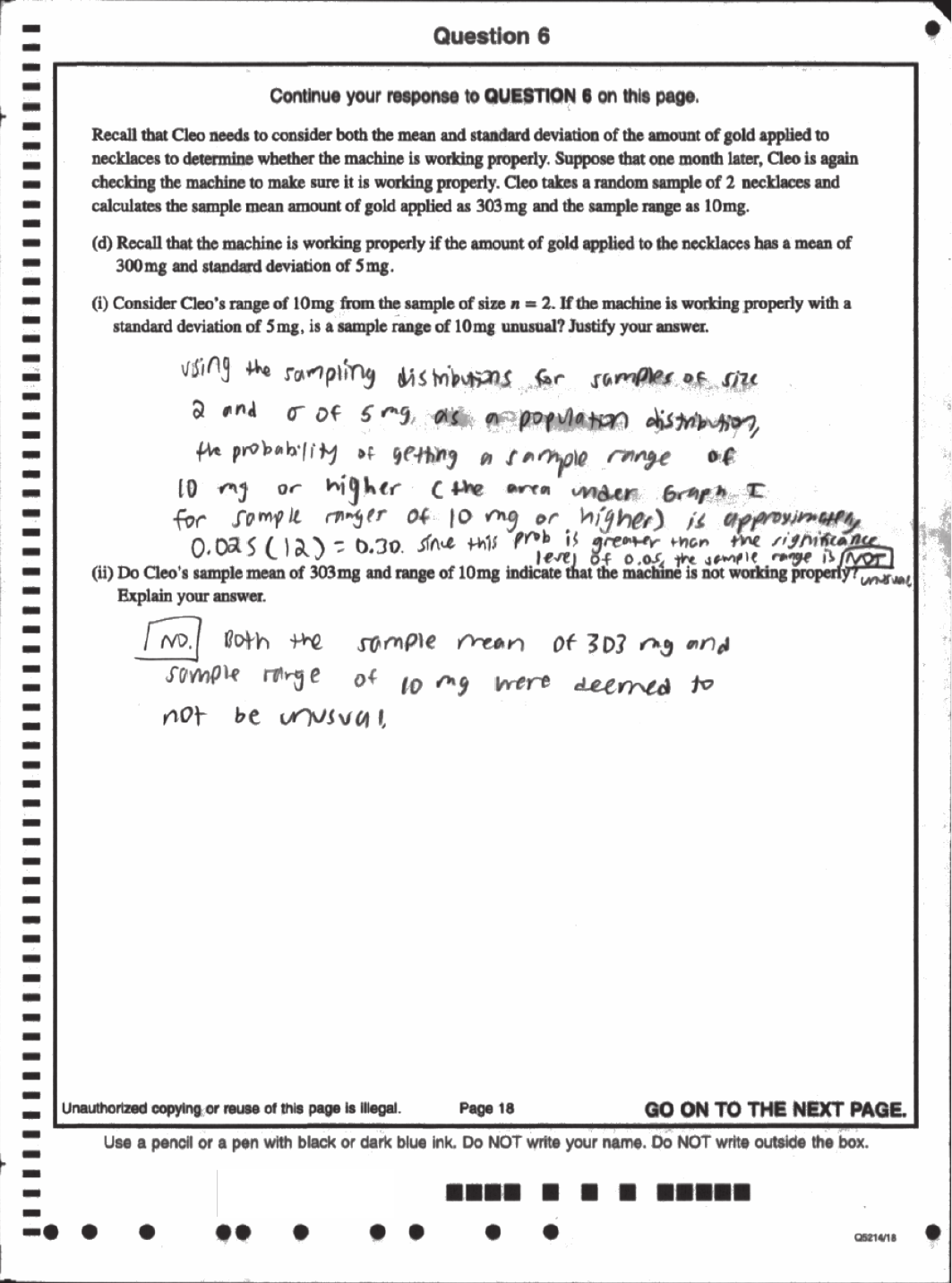
Sample 6A
5 of 5
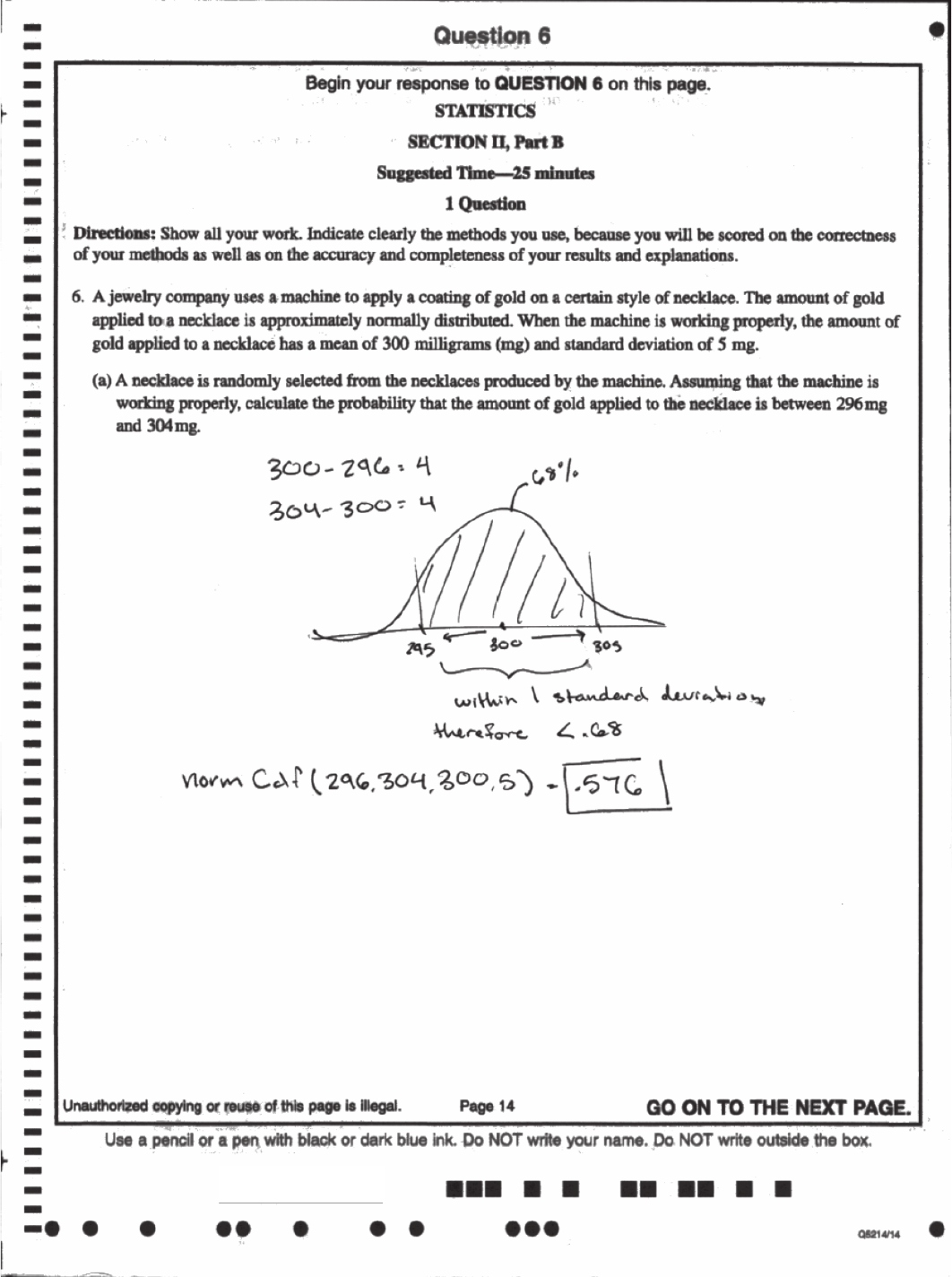
Sample 6B
1 of 5
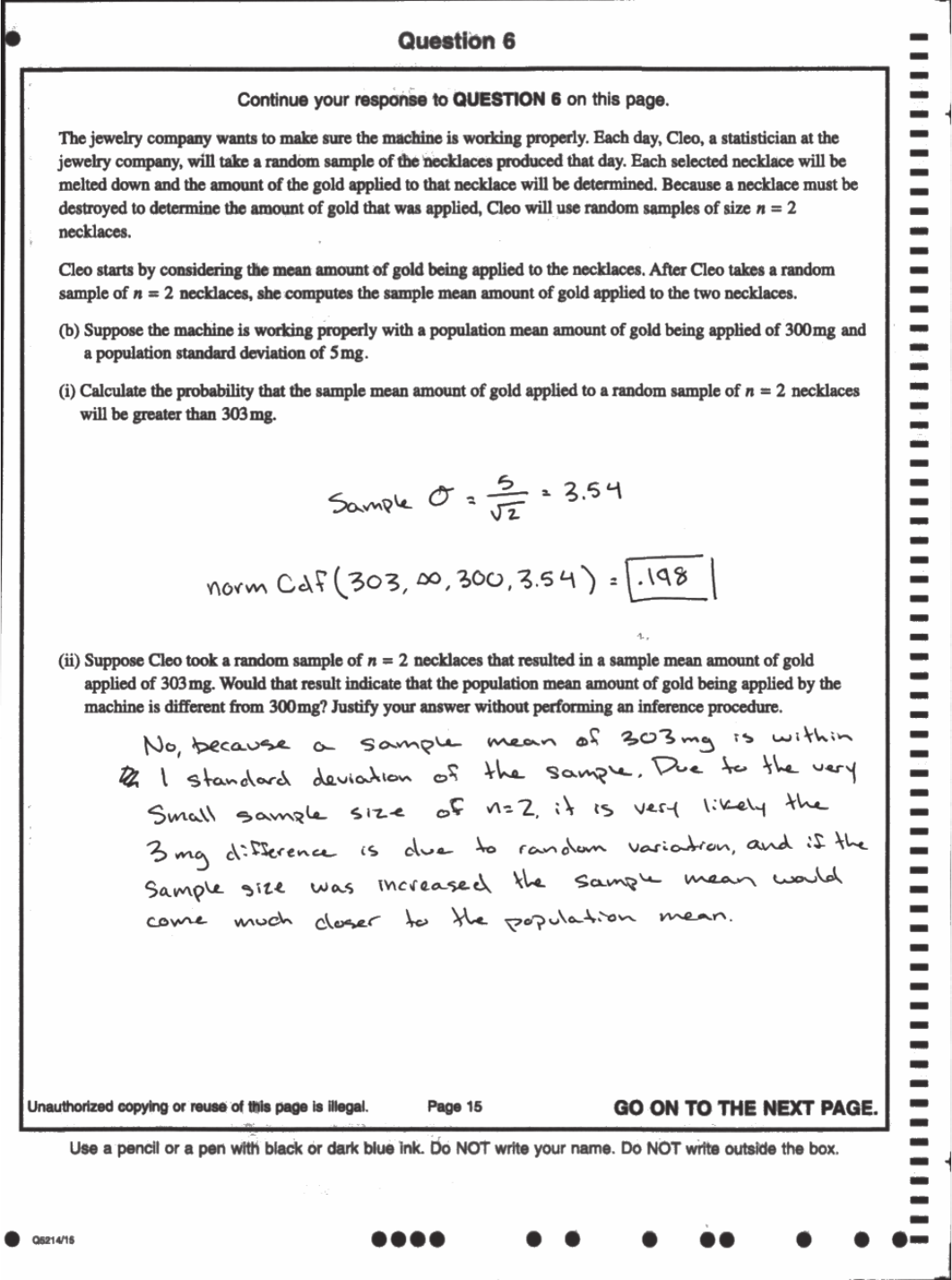
Sample 6B
2 of 5
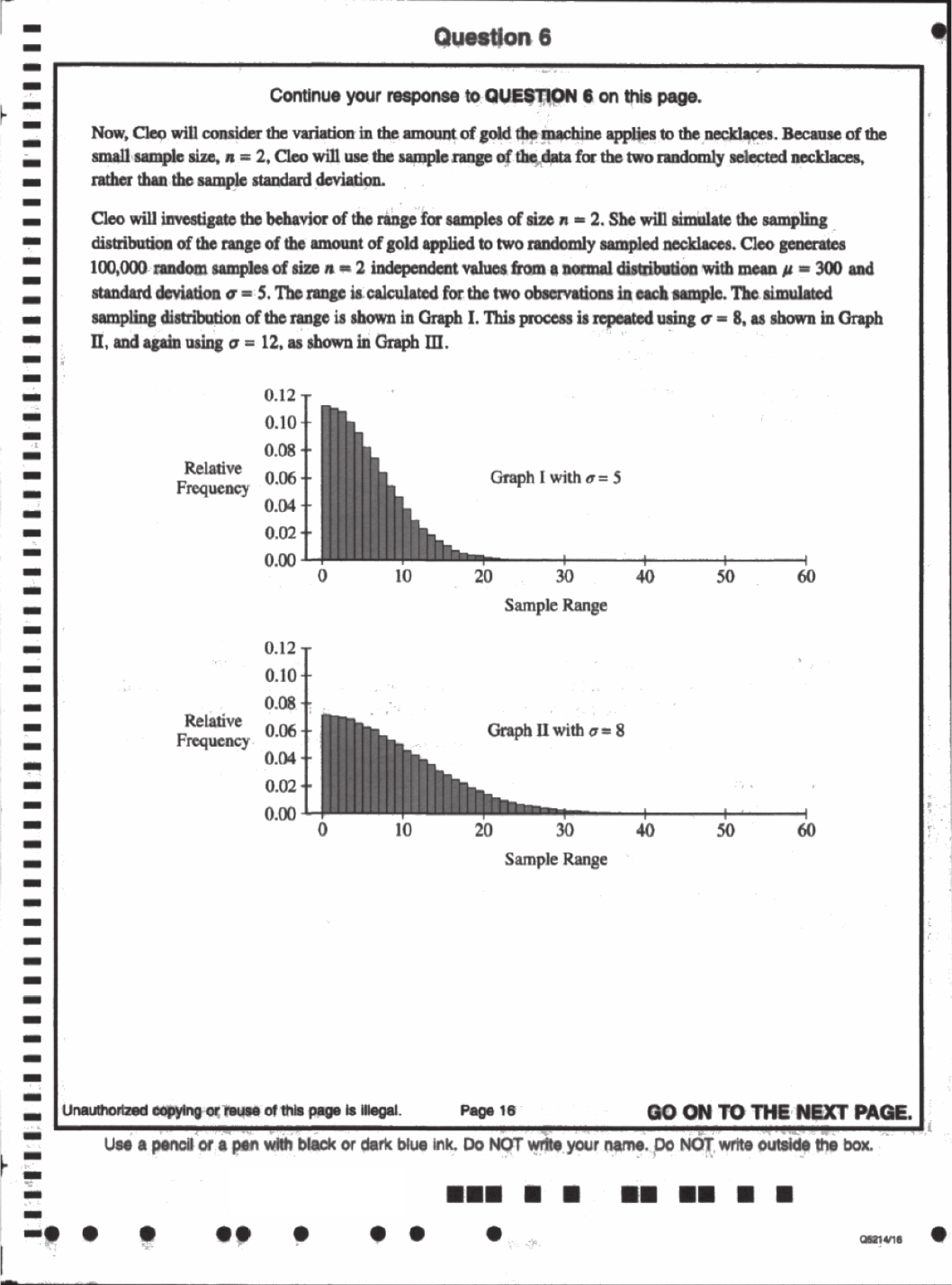
Sample 6B
3 of 5
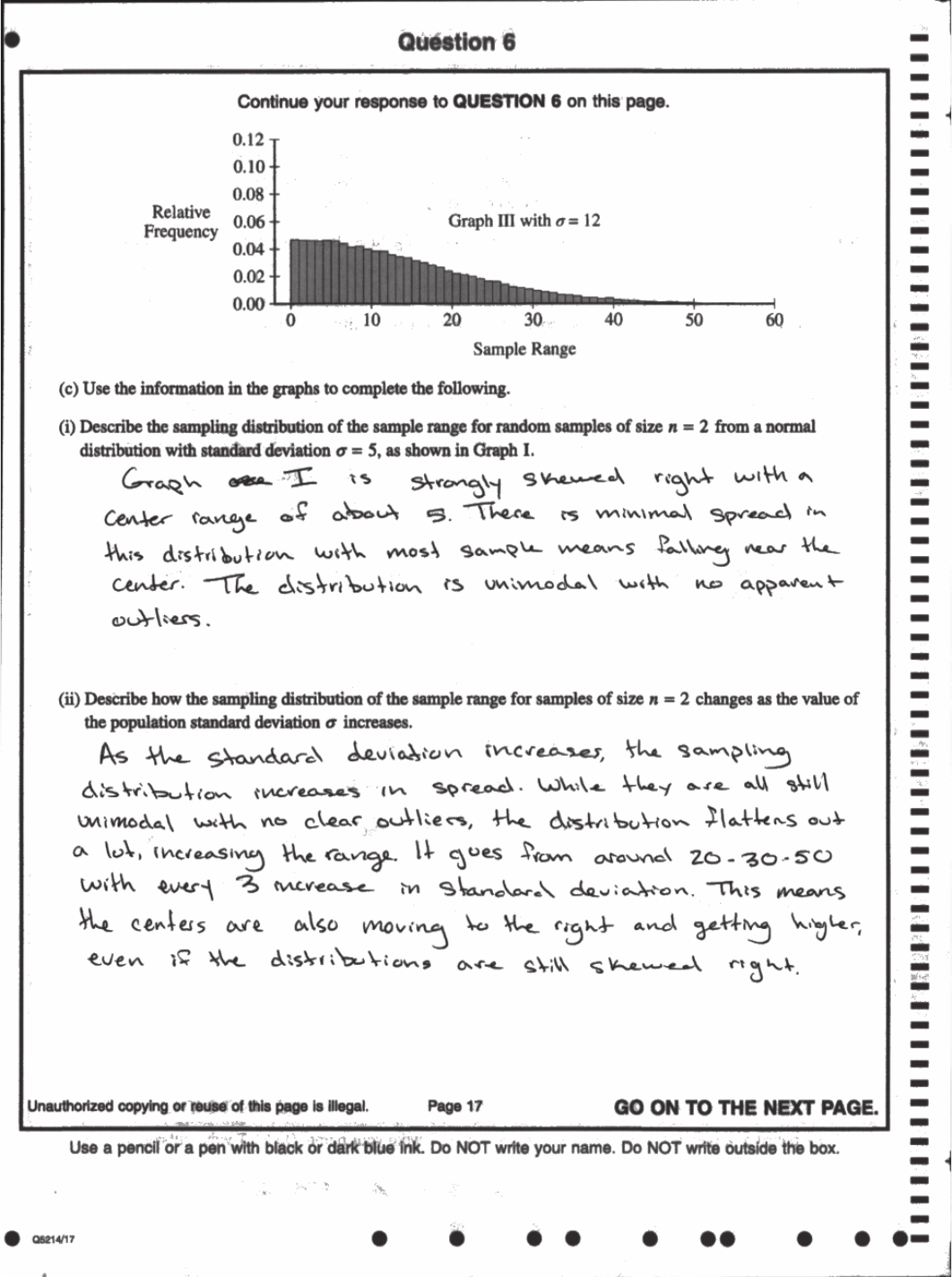
Sample 6B
4 of 5
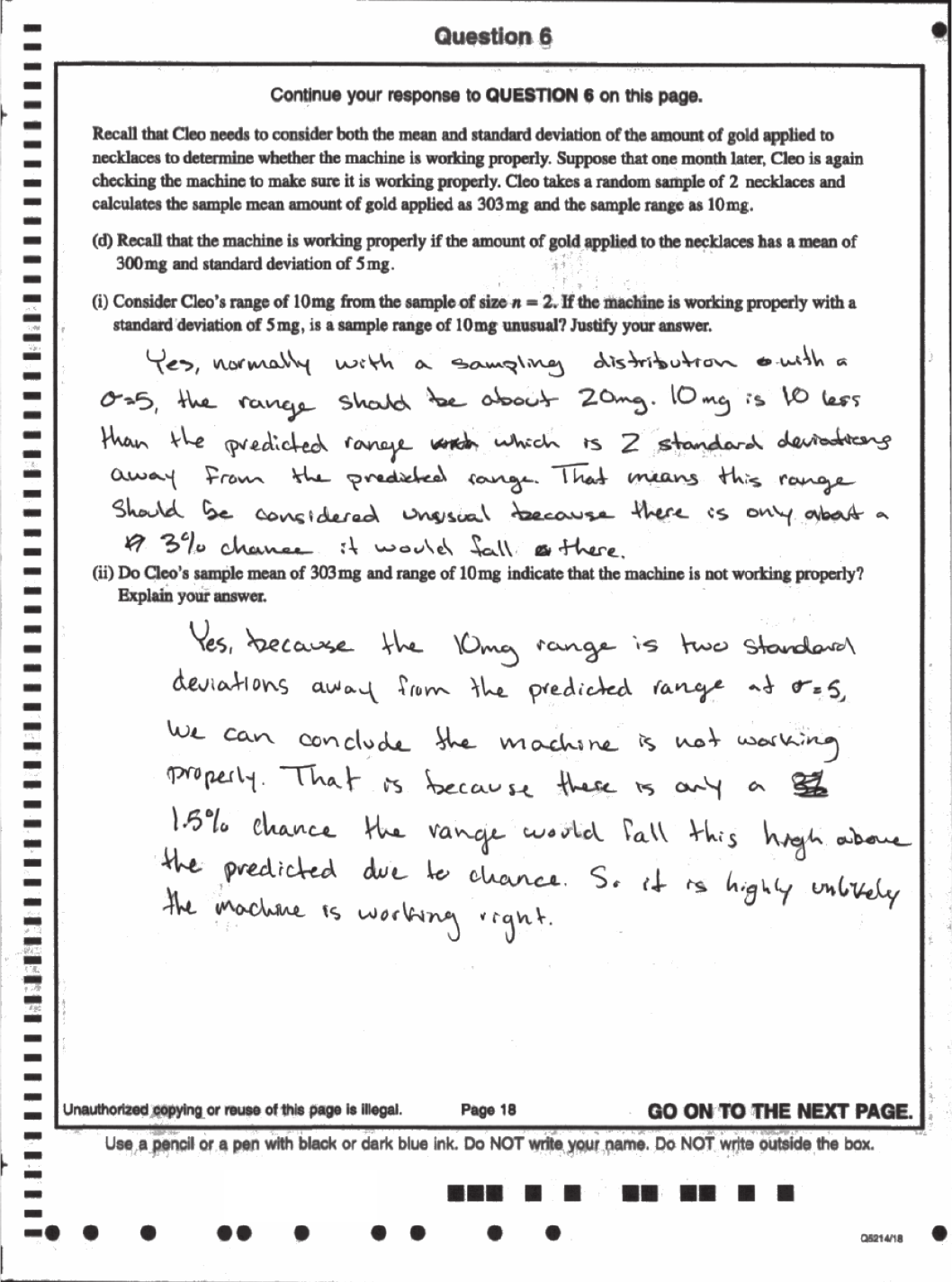
Sample 6B
5 of 5
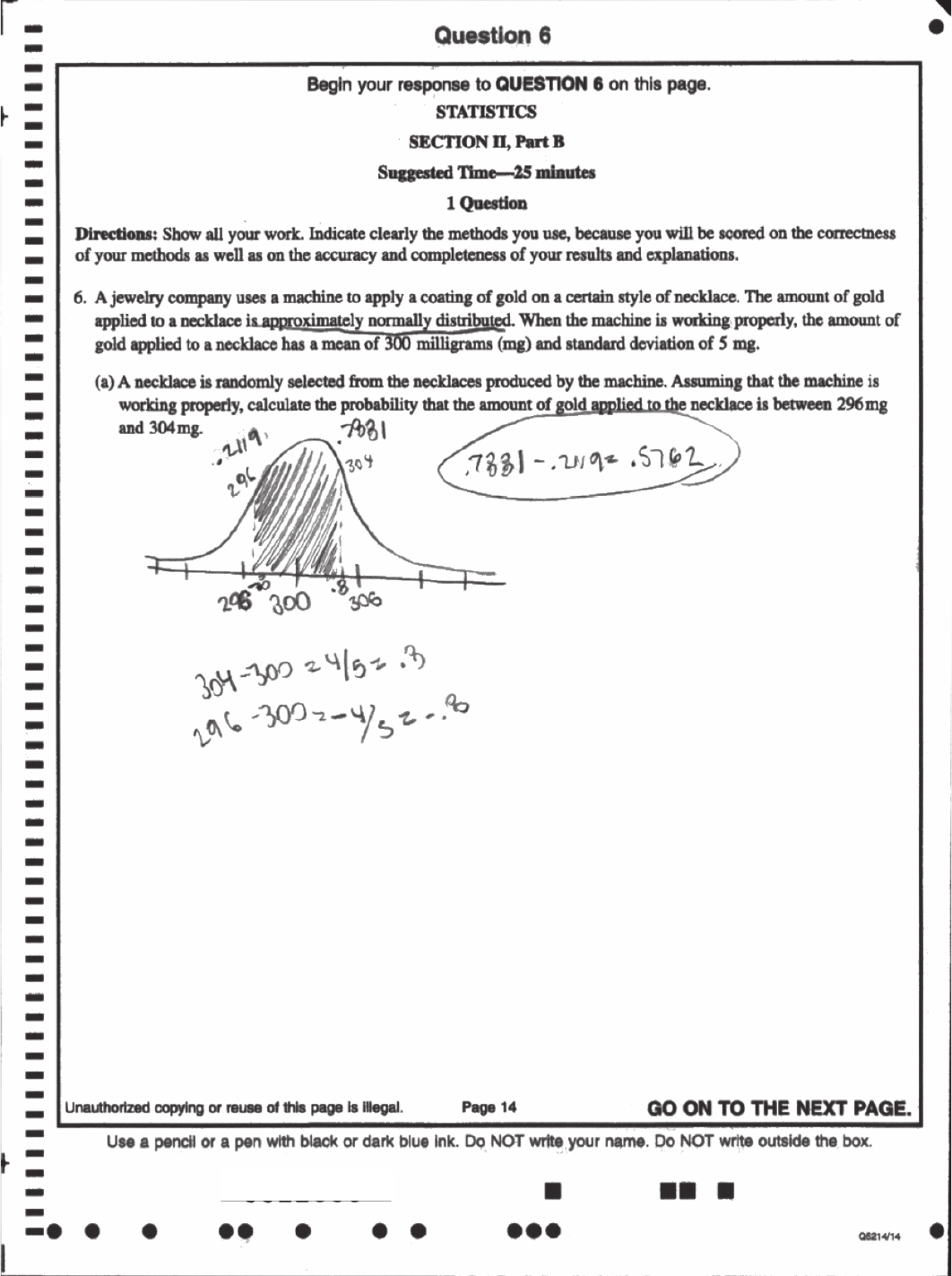
Sample 6C
1 of 5
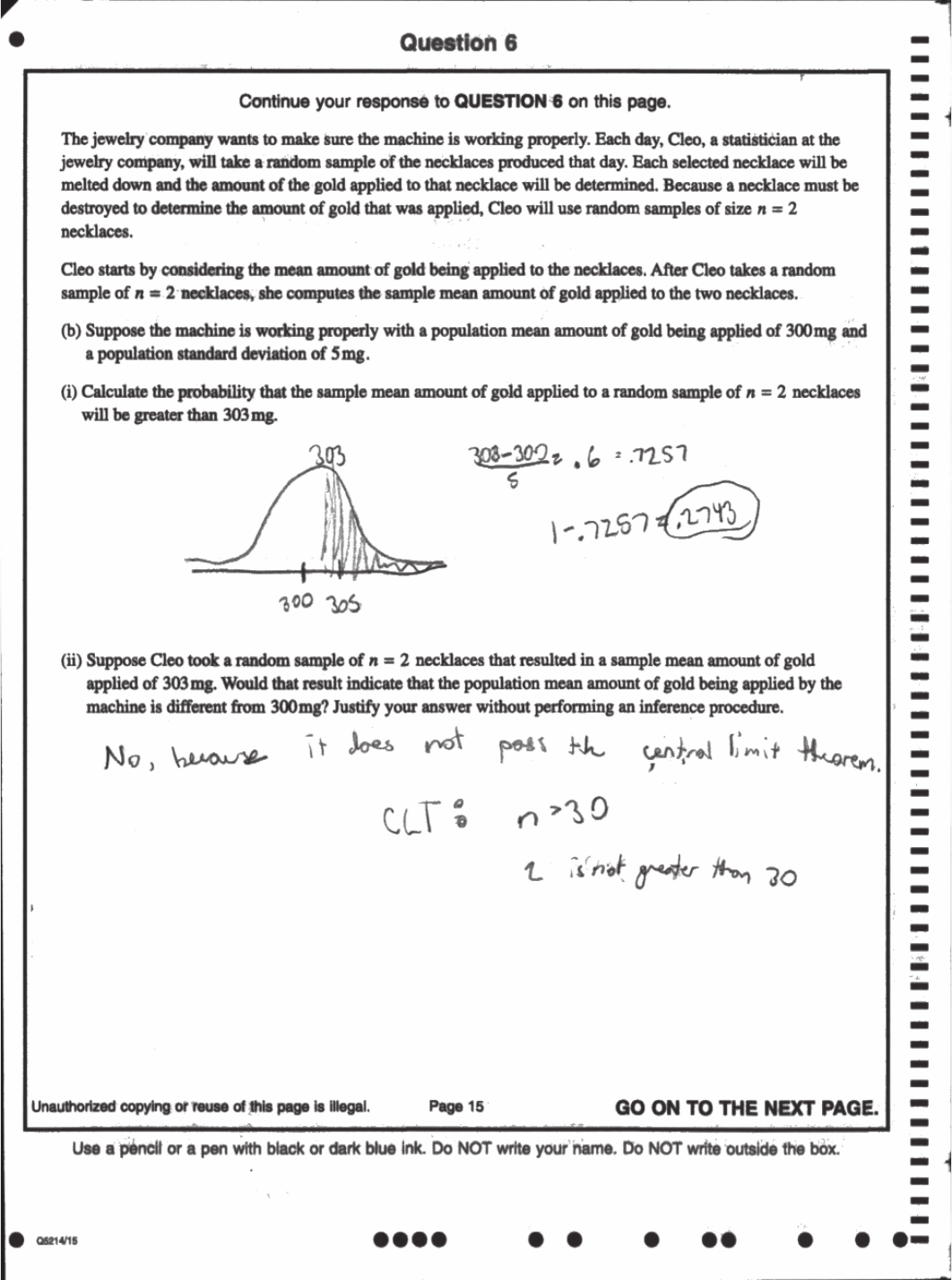
Sample 6C
2 of 5
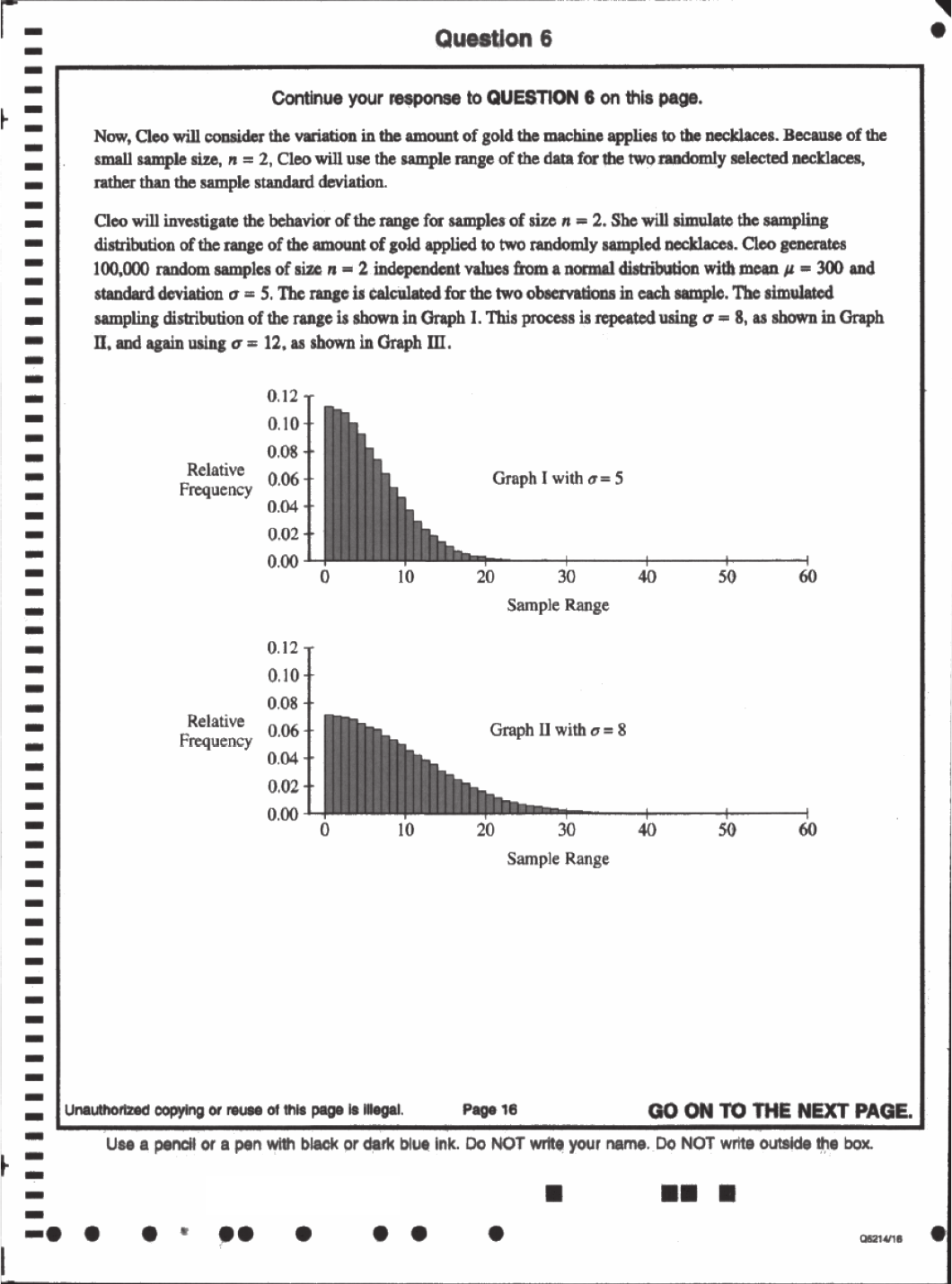
Sample 6C
3 of 5
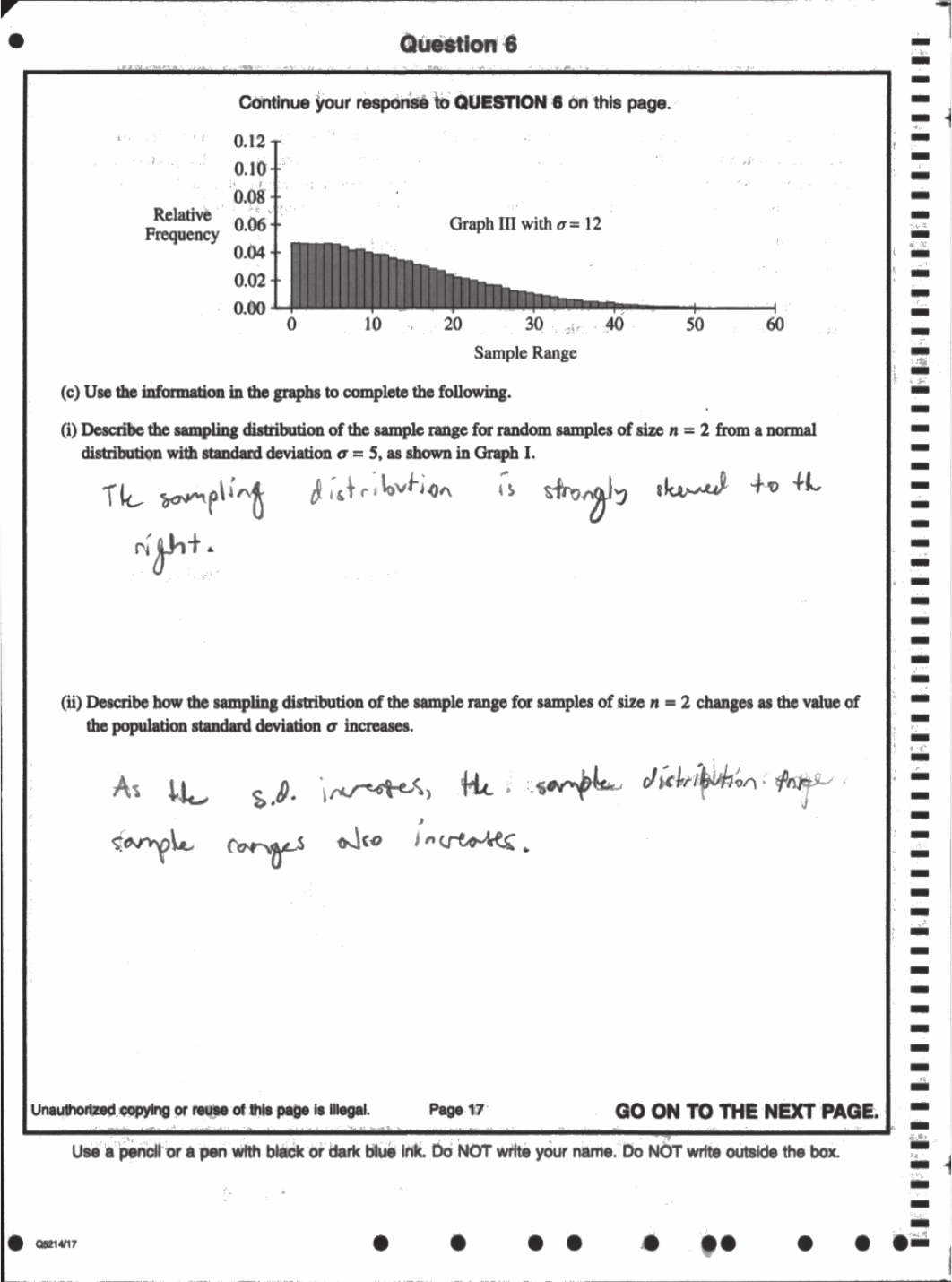
Sample 6C
4 of 5
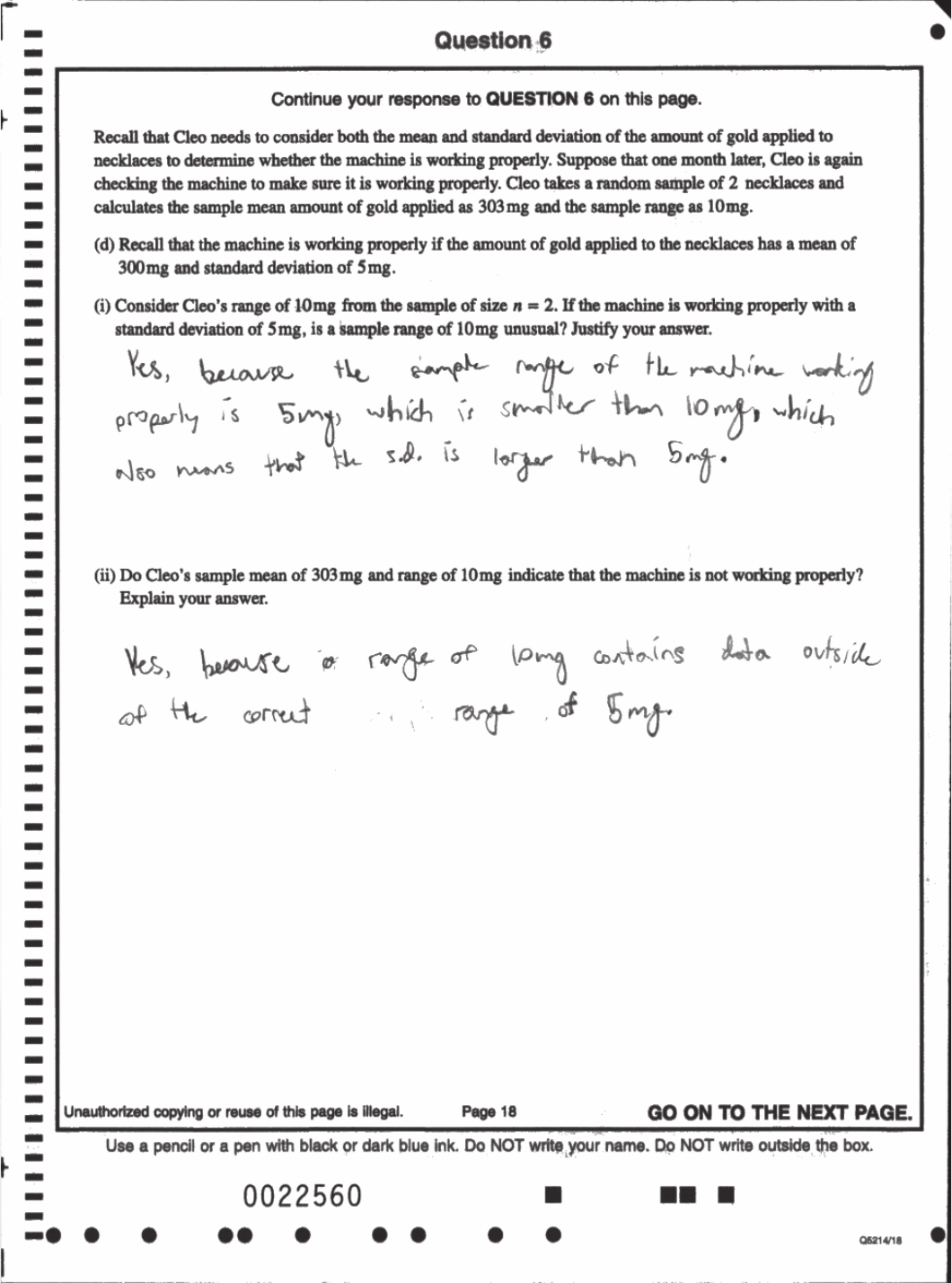
Sample 6C
5 of 5
AP
®
Statistics 2023 Scoring Commentary
© 2023 College Board.
Visit College Board on the web: collegeboard.org.
Question 6
Note: Student samples are quoted verbatim and may contain spelling and grammatical errors.
Overview
The primary goals of the question were to assess a student’s ability to (1) calculate the probability a normally
distributed random variable is between two values; (2) calculate the probability a sample mean is greater than a
value using the distribution of the sample mean; (3) interpret a probability to determine whether it implies the
population mean is a different value than what was assumed; (4) describe the sampling distribution of the sample
range, when provided a graph of the results of a simulation; (5) describe how the sampling distribution of the
sample range changes as the population standard deviation increases, based on simulated graphs; (6) determine if
a value for the sample range is unlikely based on the results of a simulation; and (7) determine whether a machine
is working properly based on the previously calculated probability for a mean and the simulated sampling
distribution for the sample range.
This question primarily assesses skills in skill category 2: Data Analysis, skill category 3: Using Probability and
Simulation, and skill category 4: Statistical Argumentation. Skills required for responding to this question include
(2.A) Describe data presented numerically or graphically, (2.D) Compare distributions or relative positions of
points within a distribution, (3.A) Determine relative frequencies, proportions, or probabilities using simulation or
calculations, and (4.B) Interpret statistical calculations and findings to assign meaning or assess a claim.
This question covers content from Unit 1: Exploring One-Variable Data, Unit 4: Probability, Random Variables,
and Probability Distributions, and Unit 5: Sampling Distributions of the course framework in the AP Statistics
Course and Exam Description. Refer to topics 1.8, 1.9, 4.7 and 5.2, and learning objectives UNC-1.M, UNC-1.N,
VAR-5.B, and VAR-6.A.
Sample: 6A
Score: 4
The response earned the following: Part (a) – E; Part (b) – E; Part (c) – E; Part (d) – E.
In part (a) the response shows a sketch of a normal curve. To the right of the sketch, the mean and standard
deviation are satisfied. Therefore, the response satisfies component 1. The boundary values are stated, and
standard probability notation is used, satisfying component 2. The response reports the correct probability,
satisfying component 3. Part (a) was scored essentially correct (E). In part (b-i) the response shows correct work
in computing the standard deviation, shows a sketch, and uses standard random variable notation, satisfying
component 1. The response indicates the correct boundary with a probability statement, satisfying component 2.
The response reports the correct probability, satisfying component 3. Although there is a small notational error,
this was ignored in scoring the response. In part (b-ii) the response states, “No,” satisfying component 4. The
response interprets the probability from part (b-i) correctly, by stating, “it is not unlikely to get that extreme of an
observation,” satisfying component 5. The response satisfies all five components. Part (b) was scored essentially
correct (E). In part (c-i) the response states, “The distribution is skewed to the right,” satisfying component 1. The
response indicates the median sample range is around 4–5. Because
5 mg
is within the range of acceptable
values, component 2 is satisfied. Finally, the response reports that the sample ranges have a range of about 23,
satisfying component 3. In part (c-ii) the response states, “The sampling distributions become less skewed to the
right,” which is extraneous. The response goes on to indicate that the range and median of the sample ranges
increase, satisfying components 4 and 5. Because all five components are satisfied, part (c) was scored essentially
correct (E). In part (d-i) the response concludes the sample range is not unusual at the end of the response,
satisfying component 1. The response indicates using the area under Graph I for ranges of 10 or greater. The
response attempts to estimate the average height of 12 bars at 10 or greater to estimate the simulated p-value.
Finally, the response uses this approximate probability to justify the response, satisfying component 2.
AP
®
Statistics 2023 Scoring Commentary
© 2023 College Board.
Visit College Board on the web: collegeboard.org.
Question 6 (continued)
In part (d-ii) the response states, “No,” satisfying component 3. The response then references the sample mean
and range having already been deemed not to be unusual. Because the response made correct numerical
arguments based on the probabilities in parts (b-i) and (d-i), the response satisfies components 4 and 5. Part (d)
was scored essentially correct (E).
Sample: 6B
Score: 2
The response earned the following: Part (a) – P; Part (b) – P; Part (c) – E; Part (d) – I.
In part (a) the response uses a sketch of a normal distribution with the mean and one standard deviation, noted
under the graph, satisfying component 1. The response does not label the graph, or use labeled calculator syntax,
standard notation, or a statement in words to establish correct boundaries, and, therefore, does not satisfy
component 2. Finally, the response reports a correct probability, satisfying component 3. Part (a) was scored
partially correct (P). In part (b-i) the response indicates normality by calculator syntax and reports the correct
standard error. However, the response does not identify the mean of the sampling distribution. Therefore
component 1 is not satisfied. The unlabeled calculator boundaries do not satisfy component 2. The response goes
on to calculate a correct probability, satisfying component 3. In part (b-ii) the response states, “No,” satisfying
component 4. The response justifies the answer by indicating that 303 is within one standard deviation of the
mean, satisfying component 5. Part (b) was scored partially correct (P). In part (c-i) the response states, “Graph I
is strongly skewed right,” satisfying component 1. The response also reports a center of about 5, satisfying
component 2. There is no acceptable value given for spread, failing to satisfy component 3. In part (c-i) the last
two sentences of the response are considered extraneous. In part (c-ii) the response goes on to state, “the sampling
distribution increases in spread,” and “the centers are also moving to the right and getting higher,” satisfying
components 4 and 5. Because the response satisfies four of the five components, part (c) was scored essentially
correct (E). In part (d-i) the response includes the incorrect answer of “Yes,” failing to satisfy component 1, with
incorrect justification. In part (d-ii) the response reiterates an incorrect conclusion and fails to correctly address
the mean or the range. Part (d) was scored incorrect (I).
Sample: 6C
Score: 1
The response earned the following: Part (a) – E; Part (b) – P; Part (c) – I; Part (d) – I.
In part (a) the response uses a sketch of a normal curve, with mean, standard deviation, and boundary values
labeled. The response also includes a correct probability. Part (a) was scored essentially correct (E). In part (b-i)
the response uses the incorrect standard deviation, failing to satisfy component 1. The sketch has the correct
boundary and direction, satisfying component 2. The response indicates a probability consistent with components
1 and 2, satisfying component 3. In part (b-ii) the response states, “No,” satisfying component 4. However, the
justification is incorrect, failing to satisfy component 5. Three of the five components are satisfied. Part (b) was
scored partially correct (P). In part (c-i) the response indicates skewness to the right, satisfying component 1. The
response fails to address components 2 or 3. In part (c-ii) the response states, “As the s.d. increases, the sample
distribution for sample ranges also increases.” However, the response does not indicate what it is about the
sampling distribution that increases. Therefore, neither components 4 nor 5 are satisfied. Part (c) was scored
incorrect (I). In part (d-i) the response includes the incorrect answer of “Yes,” failing to satisfy component 1 with
incorrect justification. In part (d-ii) the response reiterates an incorrect conclusion and fails to correctly address
the mean or the range. Part (d) was scored incorrect (I). Because the response earned 1.5 points, holistic scoring
must be used. In part (a), standard notation is not used, and the response contains an incorrect string of equalities.
In part (b-i) the response includes an incorrect string of equalities. In part (b-ii) the response satisfies component 4
by stating, “No.” However, the response is based on incorrect justification. In parts (c) and (d), the
communication is weak. The response was scored 1.
